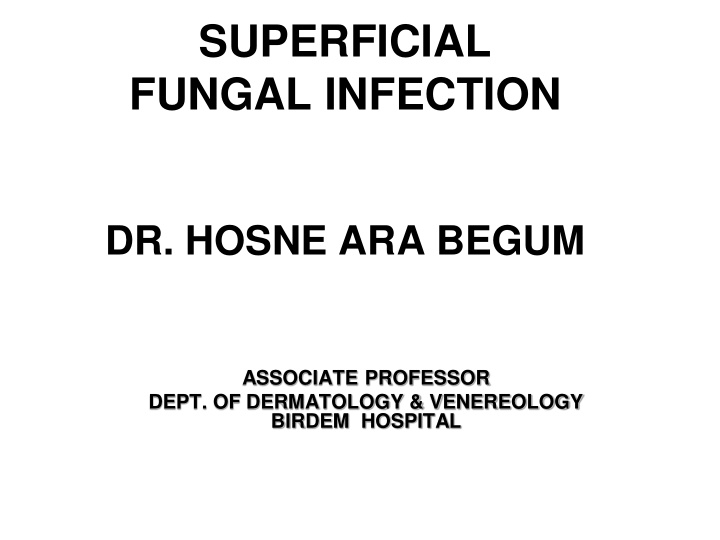



SUPERFICIAL FUNGAL INFECTION DR. HOSNE ARA BEGUM ASSOCIATE PROFESSOR DEPT. OF DERMATOLOGY & VENEREOLOGY BIRDEM HOSPITAL
Superficial Fungus Fungus may be defined as non – photosynthetic microorganism growing as a mass of branching & interlacing filaments.
Numerous fungi are capable of invading- • Epidermis , • Adnexa (hair/nail apparatus) & • Mucosal sites (oropharynx , anogenitalia).
EPIDEMIOLOGY AND INCIDENCE The incidence of fungal infection is influenced by – Geographical locations are important factors T. tonsurans, M. audouinii have been frequently noted in the New York , whereas T violaceum is prevalent in the former Soviet Union, Yugoslavia and Spain. Environmental factors : help promote the propagation of many opportunistic fungi-like excessive perspiration in hot and humid climate favours fungal infection. Genetic susceptibility : to certain forms of fungal infections may be related to the types of keratin or degree or mix of cutaneous lipids produced.
Host factors Host factors are very significant in the development of fungal infection. These include- Immunity - immuno suppressed patients are more susceptible to severe and refractory dermatophytosis. Chronic disease - like diabetes mellitus, HIV favours fungal infection. only the severity of dermatophytosis is increased with HIV, not the prevalence. Human steroid hormones - Particularly androgens such as Androstenedione can inhibit the growth of dermatophytes. ABO system- Patient with A blood group is more prone to dermatophytosis. Age, sex and race are additional important epidemiologic factors as dermatophyte infections are five times more prevalent in males than in females.
Stucture of the Skin
These fungi are commensural organism that frequently colonize normal epithelium include – a) Dermatophytes, b) Candida albcans c) Malassezia furfur. The clinical apperance of dermatophytosis depends in part on the organism involved, the site affected & host reactions.
Dermatophytosis are termed according to the sites involved. • Tinea Capitis • T. Facei • T. Barbae • T. Pedis • T. Corporis • T. Cruris • T. Manum • Onychomycosis
Tinea Capitis • Non Inflammatory type • Inflammatory type
Non Inflammatory type t. capitis • Black dot • Gray patch
Tinea Capitis
Inflammatory type of t. Capitis • Kerion • Flavus
T.Facie
T. Barbe • Superfial crusted bald patches with folliculitis. Non-Inflammatory type • Deep nodular suppurative lesions-Inflammatory type
T. Barbe
T.Corporis
Differential diagnosis of T.Corporis
T. Mannum
T.Pedis
T.Cruris
Differential diagnosis of T.Cruris
Onychomycosis
Differential diagnosis of Onychomycosis
Investigation The diagnosis is done by – - Skin scraping for 20% KOH fungus M/E - Fungus culture in sabouraud glucose agar or DTM - In some cases by Wood’s light examination.
Recommend
More recommend